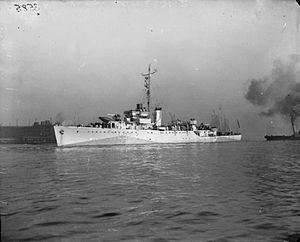Name HMS Aberdeen Laid down 12 June 1935 Commissioned 17 September 1936 Launched 22 January 1936 Draft 2.29 m | Ordered 1 March 1935 Sponsored by Mrs E Watt Construction started 12 June 1935 Length 81 m Builder Devonport Dockyard | |
 | ||
Identification Pennant number L97 (later U97) | ||
HMS Aberdeen was a Grimsby-class sloop in the British Royal Navy. Built in Devonport Dockyard, Plymouth, UK by Thornycroft (Southampton, UK), she was launched on 22 January 1936.
Contents
Service history
Aberdeen was fitted for use as despatch vessel during construction, and was used by the Commander-in-Chief of the Mediterranean Fleet up until the outbreak of World War II.
World War II
On 3 September 1939 Aberdeen was recalled to the UK and deployed with the 1st Escort Division of Western Approaches Command for convoy escort duty in the English Channel and the Southwest Approaches, based at Plymouth.
In May 1940 her pennant number was changed from L97 to U97.
In June, after the Fall of France, Atlantic convoy traffic was routed further north, and Aberdeen was transferred to Rosyth to escort of convoys in the North Sea and Northwest Approaches. In November she was transferred to the Liverpool Sloop Division for Atlantic convoy escort duty.
In June 1941 she was transferred to the 41st Escort Group based at Derry for the defence of convoys between the UK and Freetown.
In early 1942 Type 271 radar and HF/DF direction finding equipment was fitted.
In October Aberdeen escorted military convoys to Gibraltar in preparation for the landings in North Africa ("Operation Torch"), and on 8 November was deployed off Oran in support of the landings.
At the end of the year Aberdeen was refitted at a Tyne shipyard, and the "Hedgehog" anti-submarine mortar was fitted.
Aberdeen returned to duty in March 1943, joining the 40th Escort Group and sailing to St. John's, Newfoundland, where she formed part of the escort for Convoy HX229A to the UK. On the return voyage she saw four days of action in the largest convoy battle of the war, as the convoy was continually attacked by U-boats of three "wolfpacks". Aberdeen sustained some damage to her hull by running into ice.
After repairs at Liverpool, and the fitting of Type 291 radar and VHF radio communications, Aberdeen was sent to Freetown in June to join West African Command for coastal convoy and local escort duties, not returning to the UK until April 1944.
In May another refit was begun, and she sailed to HM Dockyard Bermuda for further work. Repairs were finally completed, and she returned to Freetown in September.
Post-war
After VE Day on 8 April 1945 Aberdeen remained at Freetown for local patrol and air sea rescue duties until August, before sailing to Gibraltar to be put into the Reserve. Aberdeen was placed on the Disposal List at the end of 1946. She was towed to Devonport, and sold to the British Iron and Steel Company (BISCO) on 16 December 1948 for breaking-up by Thos W Ward at Hayle, Cornwall, arriving there on 19 January 1949.
